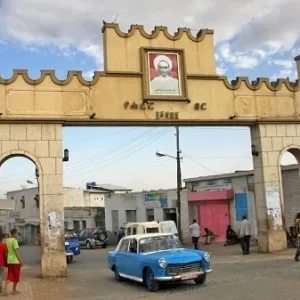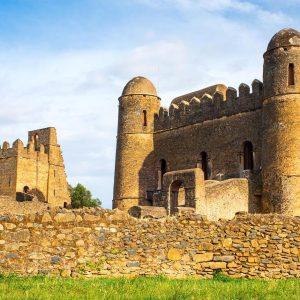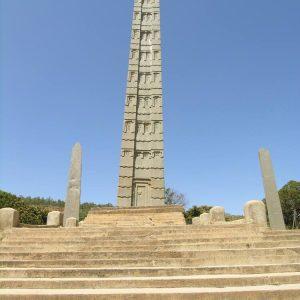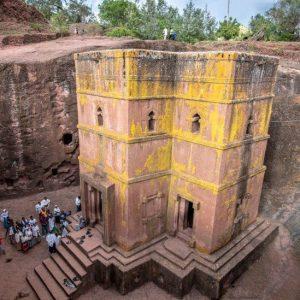Situated in the northern region of Ethiopia, Axum (also spelled Aksum) stands as a living testament to the country’s rich historical and cultural heritage. Once a powerful kingdom and an important trading center, Axum was the heart of the Aksumite Empire, one of the most influential civilizations of the ancient world. Today, it is a UNESCO World Heritage site, attracting visitors with its intriguing archaeological sites, ancient obelisks, and religious significance. Exploring Axum offers a fascinating glimpse into Ethiopia’s glorious past and its enduring legacy.
- The Historical Splendor of Axum: Axum is shrouded in captivating history, dating back to the 1st century AD. It was the capital of the Aksumite Empire, which thrived as a major trading hub along the Red Sea. The city reached its zenith in the 3rd and 4th centuries, influencing cultures as far as Egypt and India. Axum’s historical significance is evident in its archaeological sites, royal tombs, and ancient artifacts that have shaped the region’s identity.
- The Stelae and Obelisks: Axum is renowned for its towering stelae and obelisks, monumental stone pillars that served as markers of royal tombs and symbols of power. The most famous among them is the Obelisk of Axum, which stands at over 23 meters tall and weighs approximately 160 tons. Although many of these structures have fallen or been damaged over the centuries, they remain awe-inspiring remnants of Axum’s glorious past.
- The Church of St. Mary of Zion: The Church of St. Mary of Zion, a significant religious site in Axum, holds immense importance in Ethiopian Orthodox Christianity. It is believed to house the original Ark of the Covenant, a sacred artifact mentioned in the Bible. Pilgrims and locals gather at the church to pay their respects, partake in religious ceremonies, and immerse themselves in the spiritual ambiance that pervades the surroundings.
- The Ancient Underground Tombs: Axum is dotted with ancient underground tombs, known as the Queen of Sheba’s Palace and the Tombs of Kings Kaleb and Gebre Meskel. These archaeological sites offer a glimpse into the opulence and grandeur of the Aksumite Empire. The subterranean tombs are adorned with intricate carvings and architectural details, serving as a testament to the civilization’s advanced engineering skills and artistic prowess.
- Cultural Vibrancy and Artifacts: In addition to its historical sites, Axum boasts a vibrant culture and a rich collection of artifacts. The Axumite Museum houses a remarkable array of artifacts, including ancient coins, ceramics, jewelry, and statues, providing a deeper understanding of the region’s past. The vibrant local market offers a chance to engage with the friendly locals, discover traditional crafts, and sample the flavors of Ethiopian cuisine.
Ethiopia Tours
Ethiopia-Mountains Trekking Tour package (5 Nights / 6 Days )
Heritages of Northern Ethiopia Tour package (8 Nights / 9 Days )
Northern Ethiopia Tour package (6 Nights / 7 Days )
Historical Trip To The Northern Ethiopia Tour package (5 Nights / 6 Days )
Tourist Attractions in Ethiopia
Situated in the picturesque region of the Great Rift Valley, Arba Minch is a vibrant town in southern Ethiopia that …
Located in southeastern Ethiopia, the Bale Mountains National Park is a captivating destination that showcases the country’s unique alpine ecosystems …
Situated in the heart of the Great Rift Valley, Abijatta-Shalla National Park is a natural gem in Ethiopia that offers …
Deep in the heart of Ethiopia, the Blue Nile Gorge stands as a testament to the country’s awe-inspiring natural beauty. …
Located in the eastern part of Ethiopia, Awash National Park is a natural treasure that showcases the country’s diverse wildlife …
Situated in the heart of the Bale Mountains in southeastern Ethiopia, Sof Omar Cave is a natural wonder that captivates …
Situated in the heart of the Danakil Depression in northeastern Ethiopia, Lake Assal stands as a unique natural wonder. With …
Situated in the northern part of Ethiopia, the Tigray Region is a treasure trove of history, culture, and natural beauty. …
Perched atop a sheer cliff in the northern Tigray region of Ethiopia, Debre Damo stands as a testament to the …
Deep in the heart of southern Ethiopia lies the captivating Omo Valley, a cultural haven that immerses visitors in the …
Situated in the southeastern part of Ethiopia, the Bale Mountains National Park is a hidden gem that beckons nature enthusiasts …
Situated in the northern highlands of Ethiopia, Lake Tana is a mesmerizing natural gem that captivates visitors with its serene …
Located in eastern Ethiopia, Harar is a city steeped in history, culture, and Islamic heritage. Known as the “City of …
Located in the northeastern part of Ethiopia, the Danakil Depression is an otherworldly landscape that captivates with its extreme natural …
Situated on the southern shore of Lake Tana, Bahir Dar is a vibrant city that serves as a gateway to …
Situated in the highlands of northern Ethiopia, Gondar is a city steeped in history and architectural marvels. Known as the …
Situated in the northern region of Ethiopia, Axum (also spelled Aksum) stands as a living testament to the country’s rich …
Situated in the northern part of Ethiopia, the Simien Mountains National Park stands as a breathtaking testament to nature’s grandeur. …
Addis Ababa, the capital city of Ethiopia, is a dynamic and cosmopolitan destination that beautifully blends tradition and modernity. Located …
Situated in the northern highlands of Ethiopia, Lalibela is a remarkable destination that transports visitors to an ancient and spiritual …
Book Your Flights : Here 30% OFF on Booking
Book Your Hotels : Here 20% OFF on Booking
Frequently Asked Question
Axum has an airport that receives domestic flights from Addis Ababa and other major cities in Ethiopia. Alternatively, you can travel to Axum by road from other towns and cities in the region.
The Church of St. Mary of Zion is a significant religious site, and while visitors are welcome, access to the Ark of the Covenant is restricted to a select few priests. However, you can still visit the church, witness religious ceremonies, and appreciate the historical and spiritual significance of the site.
Yes, Axum offers a range of accommodation options, including hotels, guesthouses, and lodges. From budget-friendly choices to more upscale accommodations, visitors can find suitable places to stay during their visit to Axum
As Lalibela is a place of religious significance, visitors are expected to dress modestly. Both men and women should avoid wearing revealing clothing, and women are encouraged to cover their heads with a scarf while inside the churches.
The best time to visit Axum is during the dry season, which typically runs from October to May. During this time, the weather is generally pleasant and ideal for exploring the archaeological sites and enjoying outdoor activities.


























0 Comment